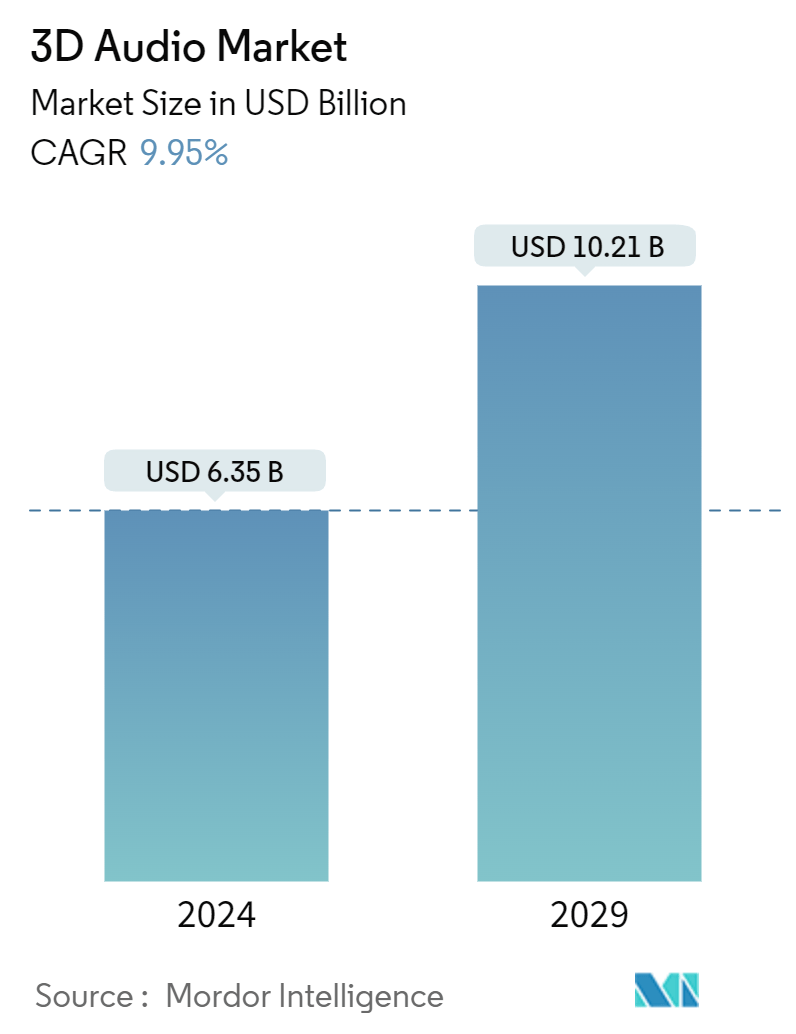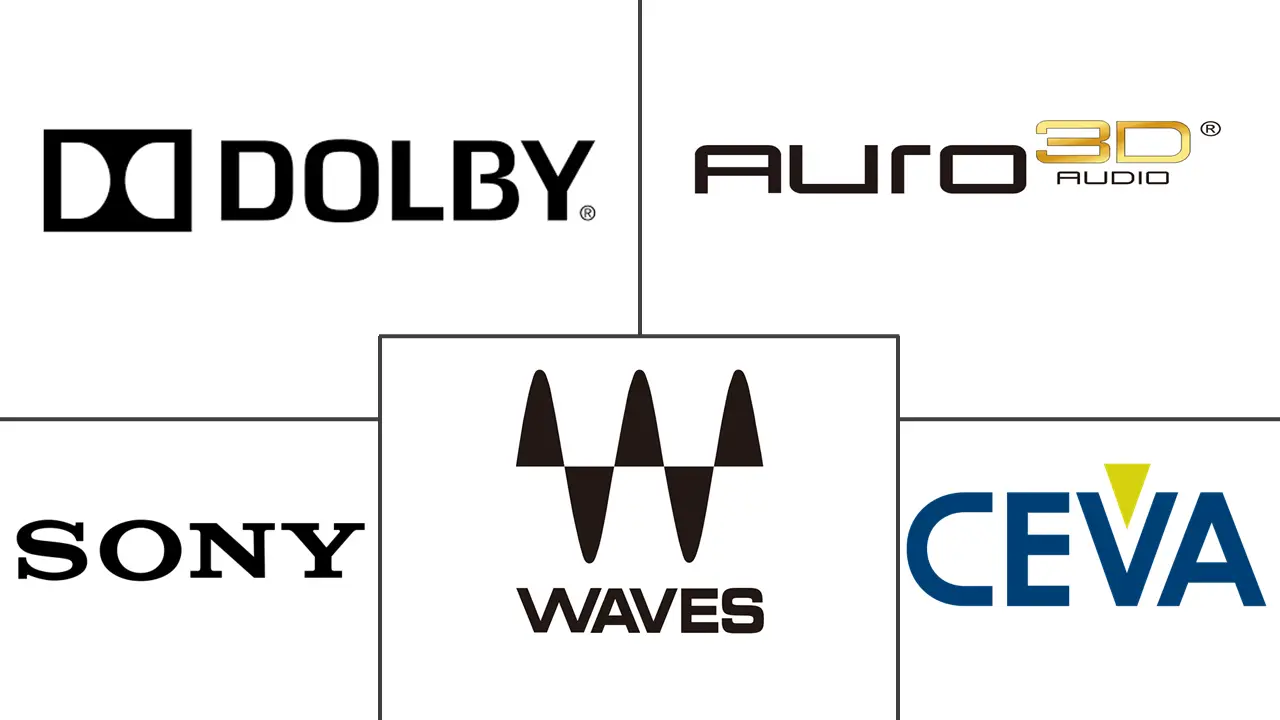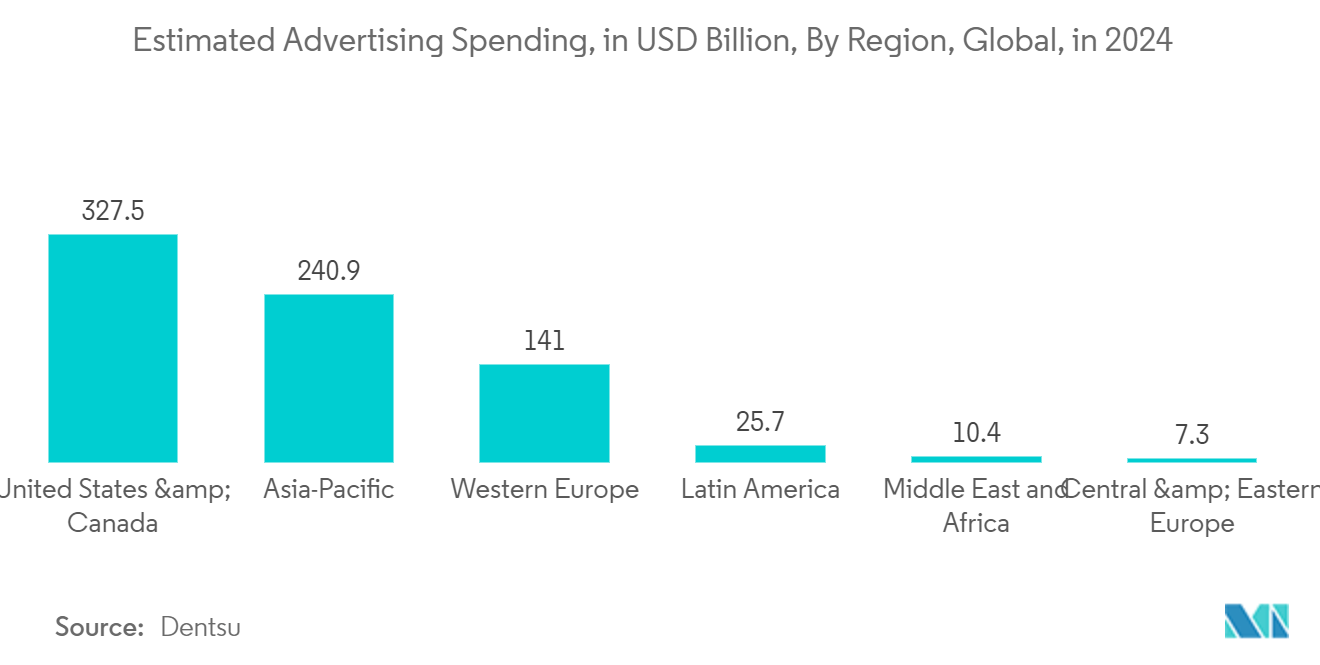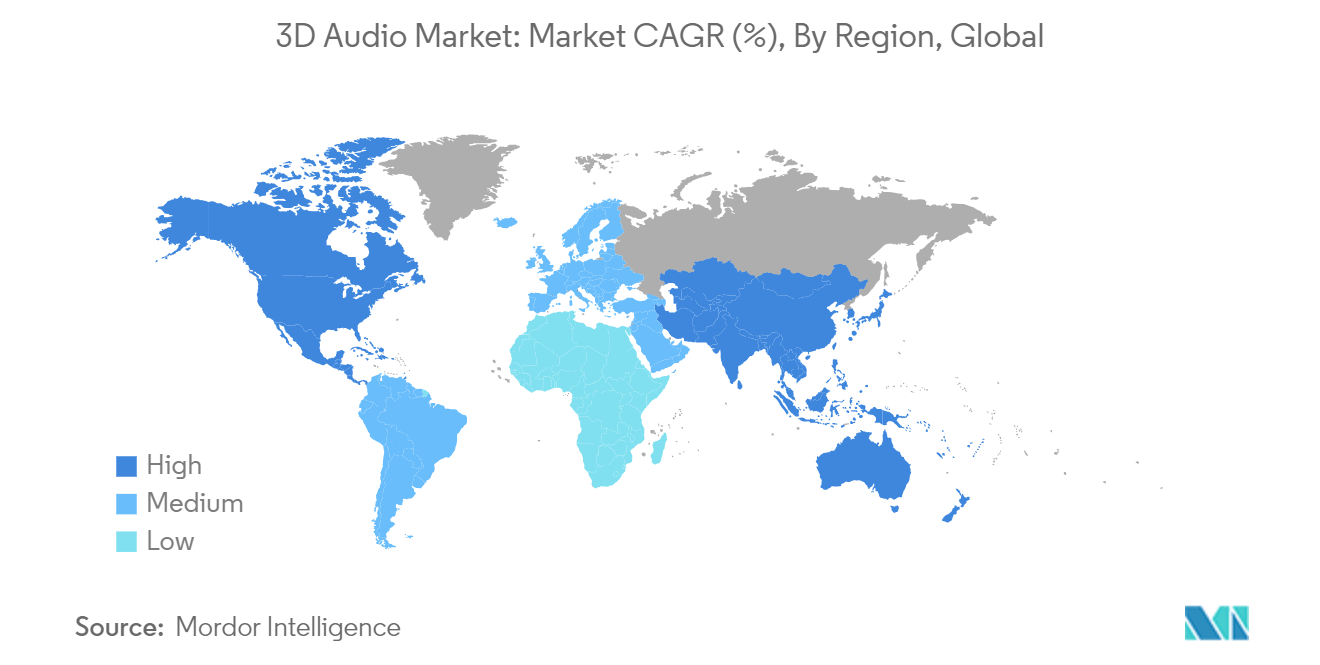3D Audio Market Size

| Study Period | 2019 - 2029 |
| Market Size (2024) | USD 6.35 Billion |
| Market Size (2029) | USD 10.21 Billion |
| CAGR (2024 - 2029) | 9.95 % |
| Fastest Growing Market | Asia Pacific |
| Largest Market | North America |
Major Players
*Disclaimer: Major Players sorted in no particular order |
3D Audio Market Analysis
The 3D Audio Market size is estimated at USD 6.35 billion in 2024, and is expected to reach USD 10.21 billion by 2029, growing at a CAGR of 9.95% during the forecast period (2024-2029).
- The increasing adoption of virtual reality (VR) and augmented reality (AR) technologies significantly drives the growth of the 3D audio market in the commercial sector. VR technology immerses users in fully simulated, computer-generated environments, making 3D audio essential for creating a truly immersive experience. Techniques such as binaural recording and head-related transfer functions (HRTFs) simulate the natural perception of sound, enhancing realism and presence in VR environments. This is particularly important for gaming, entertainment, and training applications, where 3D audio improves user engagement, spatial awareness, and overall immersion.
- The convergence of VR/AR technologies with advanced audiovisual systems increases the demand for integrated 3D audio solutions. Companies aim to provide their customers and employees with a fully immersive, multimodal experience that combines high-quality 3D audio with stunning visual elements. This integration allows for more cohesive and captivating experiences, where the audio and visual components work together to create a more profound sense of presence and engagement.
- As streaming platforms increase, the entertainment industry witnesses a surging demand for high-quality, immersive audio experiences. These platforms are channeling investments into 3D audio technologies, aiming to offer cinema-quality sound for their original content. By leveraging technologies like Dolby Atmos, DTS:X, and other 3D audio formats, they craft enveloping soundscapes that complement visuals and elevate the overall entertainment value, akin to a theatre experience.
- Implementing 3D audio typically necessitates specialized hardware, including microphones, speakers, and dedicated audio processing units. These components often come at a premium, especially compared to traditional 2D audio setups, and the costs can escalate for larger-scale commercial deployments. Additionally, achieving a genuinely immersive 3D audio experience may require multiple speakers or headphones, further inflating end-user costs.
- Deploying and maintaining a 3D audio system effectively demands specialized expertise. Audio engineers, technicians, and even end users often need training. Hiring or training personnel with the requisite skills for configuration, troubleshooting, and optimization can significantly boost deployment costs. Moreover, ongoing training and support for end users to maximize the 3D audio system's capabilities can lead to increased long-term operational expenses.
- The ongoing stock market crisis and the broader economic recession in North America are poised to significantly influence the 3D audio market, both in the short and long terms. Economic downturns often squeeze profit margins for providers of 3D audio technology and manufacturers of related equipment. With heightened price sensitivity among companies and consumers alike, there is mounting pressure to either reduce prices or introduce more budget-friendly 3D audio solutions. Such dynamics could jeopardize the industry's overall profitability. Consequently, consolidations, mergers, or even the exit of certain players from the 3D audio arena as they grapple with maintaining their competitive edge.
3D Audio Market Trends
Commercial Segment is Expected to Hold Significant Share
- Hotels, restaurants, and bars employ 3D audio to craft ambient soundscapes, transporting customers to diverse environments and enriching their experiences. Retailers harness 3D audio to navigate customers through their stores, spotlight particular products, and forge a more unforgettable shopping journey. For instance, luxury hotels might simulate the sounds of a tropical beach or an upscale lounge using 3D audio. In contrast, retail outlets could guide shoppers through various product sections with pertinent audio cues.
- Aviation, military, and healthcare industries depend on training and simulation programs to prepare their personnel for real-world challenges. These simulations gain heightened realism by integrating 3D audio technologies, offering trainees an experience that closely mirrors actual scenarios. For instance, in a flight simulator, 3D audio can replicate an aircraft's sounds—like engine noise, wind, and radio communications—enhancing the training environment's authenticity.
- The major corporate companies are incorporating 3D audio features into their internal communication tools, including video conferencing and team collaboration platforms. This integration allows remote and distributed teams to enjoy a more authentic and engaging communication experience, enhancing collaboration, boosting productivity, and elevating overall job satisfaction. For example, during a virtual team meeting, 3D audio can recreate the ambiance of a physical conference room, making it seem as though each participant's voice emanates from their specific location in the virtual environment.
- Advertisers and marketing agencies increasingly use 3D audio technologies to develop more immersive and impactful advertising campaigns in physical and digital environments. Additionally, according to Dentsu's projections, the combined advertising expenditure in the United States and Canada will approach USD 328 billion in 2024, representing over 40% of the worldwide ad spend, which is a positive sign for the market studied.
- Brands leverage spatial audio to set themselves apart, forge deeper emotional ties with their audience, and create unforgettable brand experiences. For instance, a marketing campaign for a luxury car brand may use 3D audio to simulate the sound of the vehicle's engine and the driving experience, creating a more visceral connection with potential customers.

North America is Expected to Hold Significant Market Share
- The rapid development of advanced audio technologies, such as object-based audio, Dolby Atmos, and DTS:X, has enabled the creation of immersive 3D audio experiences. These technologies position sound objects in a 3D space, enhancing the realism and engagement of the listening experience.
- The North American entertainment industry, particularly the film, gaming, and music sectors, has been at the forefront of adopting 3D audio technologies. Consumers in this region increasingly demand more immersive and engaging audio experiences in their entertainment content. For example, major Hollywood studios, including Disney, Warner Bros., and Universal Pictures, have integrated Dolby Atmos and other 3D audio technologies into their blockbuster releases, responding to the regional audience's demand for immersive audio experiences.
- The rise of advanced headphones and earphones equipped with 3D audio capabilities has spurred the growing adoption of 3D audio technology. This trend is primarily fueled by consumers' desires for more immersive and tailored audio experiences, particularly in realms like gaming, virtual reality, and music. For instance, Apple's AirPods Pro and AirPods Max have recorded significant market shares in the North American market and boast spatial audio technology, delivering a truly immersive listening experience.
- Significant technology and entertainment companies, including Dolby, DTS, Apple, and Microsoft, spearhead the adoption of 3D audio technologies in North America. Their strategic investments and collaborations with content creators and device manufacturers have significantly bolstered the region's 3D audio market.

3D Audio Industry Overview
The 3D audio market is highly competitive, with numerous players vying for market share. To remain competitive, companies prioritize frequent technology upgrades and new developments. Additionally, they adopt partnerships and collaborations with major players in the market and focus on mergers and acquisitions of other leading players. Some of the leading players in the market are Dolby Laboratories Inc., Auro-3D (NEWAURO BV), Waves Audio Ltd, Sony Corporation, and Ceva Inc.
- In June 2024, Waves Audio unveiled a significantly upgraded version of StudioVerse, its online library for audio and instrument chains. This substantial enhancement, part of the Waves plugin catalog's V15 update, introduced instrument chains to StudioVerse through the newly launched StudioVerse Instruments plugin. This empowers users to play, browse, and audition thousands of custom-designed instrument presets directly from the StudioVerse library. Additionally, the revamped StudioVerse Audio Effects plugin, a rebranded and enhanced iteration of Waves StudioRack, boasts an upgraded user interface and improved features, all seamlessly integrated within DAW.
- In May 2024, VIZIO and Dolby Laboratories Inc. collaborated to expand the reach of Dolby Atmos, embedding top-tier immersive audio into VIZIO’s complete 2024 soundbar range. Their partnership enriched countless homes across North America with unparalleled sound and visual experiences. Milestones include debuting the world’s first TVs featuring Dolby Vision, incorporating Dolby Vision into VIZIO’s entire 4K TV range, and, most recently, rolling out Dolby Atmos in all of VIZIO’s new soundbars. With this latest Dolby-powered product lineup, VIZIO is at the forefront, democratizing access to transformative, immersive entertainment.
3D Audio Market Leaders
-
Dolby Laboratories, Inc.
-
Auro-3D (NEWAURO BV)
-
Waves Audio Ltd.
-
Sony Corporation
-
Ceva, Inc.
*Disclaimer: Major Players sorted in no particular order

3D Audio Market News
- June 2024: Nokia achieved a milestone by conducting the world's first live immersive voice and audio call over a cellular network. This groundbreaking feat utilizes the new Immersive Voice and Audio Services (IVAS) codec technology, set to be a cornerstone of the forthcoming 5G Advanced standard. Unlike traditional monophonic smartphone calls, the IVAS codec offers consumers a real-time, spatial sound experience. This enhancement elevates the richness and quality of the call and introduces a three-dimensional sound dimension, making interactions feel more lifelike and engaging. Such advancements promise a plethora of benefits for both personal and professional communication. Furthermore, this immersive communications technology is poised to elevate XR and metaverse interactions.
- December 2023: Samsung and Google collaborated to form a new audio technology, IAMF, which aims to rival Dolby ATMOS. This 3D audio technology seeks to elevate the audio handling capabilities of home systems. IAMF specializes in virtual sound processing across both horizontal and vertical planes. Additionally, it leverages AI for real-time media analysis and tuning, enhancing the overall sound output. A feature of IAMF is its customizability, a capability currently absent in Dolby ATMOS. Furthermore, Samsung aims to synchronize audio data with its home systems, matching the hardware's sound signature for a richer, more immersive audio experience.
3D Audio Market Report - Table of Contents
1. INTRODUCTION
- 1.1 Study Assumption and Market Definition
- 1.2 Scope of the Study
2. RESEARCH METHODOLOGY
3. EXECUTIVE SUMMARY
4. MARKET INSIGHTS
- 4.1 Market Overview
-
4.2 Industry Attractiveness - Porter's Five Forces Analysis
- 4.2.1 Threat of New Entrants
- 4.2.2 Bargaining Power of Buyers
- 4.2.3 Bargaining Power of Suppliers
- 4.2.4 Threat of Substitute Products
- 4.2.5 Intensity of Competitive Rivalry
- 4.3 Industry Value Chain Analysis
- 4.4 An Assessment of Macroeconomic Trends on the Market
5. MARKET DYNAMICS
-
5.1 Market Drivers
- 5.1.1 Rising Embrace of Virtual Reality (VR) and Augmented Reality (AR) Technologies
- 5.1.2 Surging Digital Entertainment Industry
-
5.2 Market Restraints
- 5.2.1 High Deployment Costs
- 5.2.2 Shortage of Expertise and Resources for Producing Premium 3D Audio Content
6. MARKET SEGMENTATION
-
6.1 By Component
- 6.1.1 Hardware
- 6.1.1.1 Speakers
- 6.1.1.2 Headphones
- 6.1.1.3 Sound Bars
- 6.1.1.4 Microphones
- 6.1.1.5 Other Hardware
- 6.1.2 Software
- 6.1.3 Services
-
6.2 By End-user Industry
- 6.2.1 Residential
- 6.2.2 Commercial
-
6.3 By Geography***
- 6.3.1 North America
- 6.3.2 Europe
- 6.3.3 Asia
- 6.3.4 Australia and New Zealand
- 6.3.5 Latin America
- 6.3.6 Middle East and Africa
7. COMPETITIVE LANDSCAPE
-
7.1 Company Profiles*
- 7.1.1 Dolby Laboratories Inc.
- 7.1.2 Auro-3D (NEWAURO BV)
- 7.1.3 Dirac Research AB
- 7.1.4 Waves Audio Ltd
- 7.1.5 Sony Corporation
- 7.1.6 Sennheiser Electronic GmbH & Co. KG
- 7.1.7 Ceva, Inc.
- 7.1.8 DTS, Inc. (A Part of XPERI)
- 7.1.9 WiSA Technologies Inc.
- 7.1.10 HARMAN International (A Samsung Company)
8. INVESTMENT ANALYSIS
9. FUTURE OF THE MARKET
** Subject To Availablity3D Audio Industry Segmentation
3D audio effects manipulate sounds produced by various audio systems, including stereo speakers, surround-sound setups, speaker arrays, and headphones. These effects often involve virtually positioning sound sources in three-dimensional space, allowing sounds to emanate from locations such as behind, above, or below the listener. The report's scope monitors the revenue from hardware, software, and service sales in the 3D audio market. Furthermore, it examines the growth trends and macroeconomic factors influencing the market.
The 3D audio market is segmented by component (hardware [speakers, headphones, sound bars, microphones, other hardware], software, and services), end-user industry (residential and commercial), and geography (North America, Europe, Asia, Australia, and New Zealand, Latin America, and Middle East and Africa). The market sizes and forecasts are provided in terms of value (USD) for all the above segments.
| By Component | Hardware | Speakers |
| Headphones | ||
| Sound Bars | ||
| Microphones | ||
| Other Hardware | ||
| By Component | Software | |
| Services | ||
| By End-user Industry | Residential | |
| Commercial | ||
| By Geography*** | North America | |
| Europe | ||
| Asia | ||
| Australia and New Zealand | ||
| Latin America | ||
| Middle East and Africa |
3D Audio Market Research FAQs
How big is the 3D Audio Market?
The 3D Audio Market size is expected to reach USD 6.35 billion in 2024 and grow at a CAGR of 9.95% to reach USD 10.21 billion by 2029.
What is the current 3D Audio Market size?
In 2024, the 3D Audio Market size is expected to reach USD 6.35 billion.
Who are the key players in 3D Audio Market?
Dolby Laboratories, Inc., Auro-3D (NEWAURO BV), Waves Audio Ltd., Sony Corporation and Ceva, Inc. are the major companies operating in the 3D Audio Market.
Which is the fastest growing region in 3D Audio Market?
Asia Pacific is estimated to grow at the highest CAGR over the forecast period (2024-2029).
Which region has the biggest share in 3D Audio Market?
In 2024, the North America accounts for the largest market share in 3D Audio Market.
What years does this 3D Audio Market cover, and what was the market size in 2023?
In 2023, the 3D Audio Market size was estimated at USD 5.72 billion. The report covers the 3D Audio Market historical market size for years: 2019, 2020, 2021, 2022 and 2023. The report also forecasts the 3D Audio Market size for years: 2024, 2025, 2026, 2027, 2028 and 2029.
3D Audio Industry Report
Statistics for the 2024 3D Audio market share, size and revenue growth rate, created by Mordor Intelligence™ Industry Reports. 3D Audio analysis includes a market forecast outlook for 2024 to 2029 and historical overview. Get a sample of this industry analysis as a free report PDF download.



